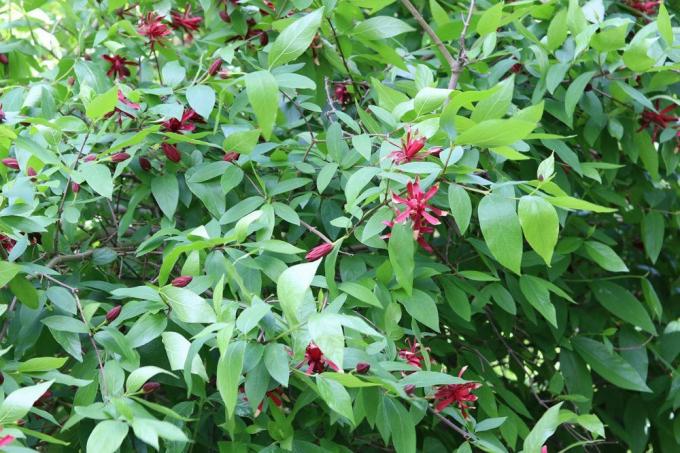
table of contents
- care
- Location
- plants
- to water
- Fertilize
- Cut
- Overwinter
- Multiply
- Diseases
Profile and care information open +conclude -
- Flower color
- red, brown
- Location
- Partial shade, sunny
- Heyday
- May June July
- Growth habit
- upright, spreading, bushy
- height
- up to 250 centimeters high
- Soil type
- sandy, loamy, gritty, clayey
- Soil moisture
- moderately moist, fresh
- PH value
- neutral, slightly acidic
- Limescale tolerance
- Calcium tolerant
- humus
- rich in humus
- Poisonous
- Yes
- Plant families
- Aromatic shrub family, Calycanthaceae
- Plant species
- Ornamental trees, fragrant plants
- Garden style
- Ornamental garden, residential garden
The real spice shrub Calycanthus floridus lives up to its name, because especially in the evening hours, flowers, leaves and bark give off different but very pleasant scents. While its wood smells of cloves, the scent of flowers is often perceived as magnolia or strawberry-like. In addition to the intense fragrances, the graceful, rust-brown flowers that stand out Their shape is also reminiscent of magnolias and on the green foliage for unique contrasts care for.
care
Calycanthus floridus grows as an upright, spreading shrub, whereby it can reach heights of growth of up to 250 cm. It is a very decorative wood that is suitable both for planting in the garden and for keeping in a container. It owes its increasing popularity to its striking flowers and the spicy, aromatic and sweet scents of the wood, leaves and flowers. The scents vary from plant to plant and in their intensity.
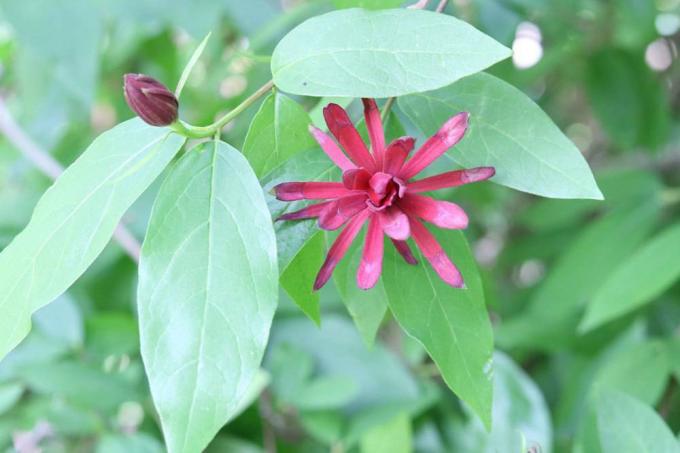
Even if the scents of this plant can for the most part keep insect pests away, it has little to counter improper care. Basically, however, it is quite robust and, if you pay attention to a few things, easy to cultivate. The only downer is their toxicity, because fruits and seeds of the real spice bush are poisonous, which should be considered especially when children or Pets could come into contact with it.
Location
The real spice bush especially likes sheltered, warm and light-flooded locations, whereby it feels most comfortable in light penumbra, for example under larger trees. The right location is important, on the one hand, for lush blooming, and on the other hand, for the fragrance to develop. Locations in full shade are less recommended, as the plants would wither and develop significantly fewer of these beautiful deep red flowers.
Because of the pleasant scent, a place near seats or terraces is particularly recommended, so that the scent can be enjoyed to the full. This aromatic plant can be planted out in the garden, ideally as a solitary plant, as well as in pots or tubs. This plant is a must, especially in fragrance and aroma gardens.
floor
The real spice shrub Calycanthus floridus develops the spiciest and most intense scents on loose, humus-rich, moderately moist and nutrient-rich soils. Sandy-loamy and loamy-clay soils as well as those with a neutral to slightly acidic pH value are good. Above all, they should be well-drained to avoid waterlogging, as the spice bush doesn't like that at all.
By incorporating humus and coarse components such as B. For example, gravel can be used to improve the permeability of heavily clayey soils. In addition, humus can enhance pure sandy soils. Clay and compost, on the other hand, can improve sandy soils. Commercially available potting soil or potting soil is suitable for planting in a tub. a good and nutrient-rich standard soil, with sand or perlite mixed in for better permeability.

plants
Plant in the garden
Before you start planting, you should consider that this spice shrub can get relatively old and grows both in height and expansively in width. Depending on the location, its offshoots can spread to neighboring beds. Unintentional spreading can be avoided by regularly removing these offshoots. Because of this, the location should be well chosen.
- in principle, planting is possible from early spring to late autumn
- The soil should definitely be frost-free
- Planting this herb in autumn is particularly recommended
- so it can grow well up to winter and sprout without delay in spring
- autumn is also the best time to transplant
- Before planting, water the root ball thoroughly and extensively
- In the meantime, dig a correspondingly large planting hole
- it should be at least twice as deep and wide as the root ball
- If there are several specimens, keep a planting distance of at least 100 cm
- If necessary, mix the excavated earth with compost or horn shavings
- Spread a layer of coarse gravel in the planting hole to improve permeability
- then put some soil and the plant in the middle
- Plant as deep as it was previously in the pot or plant container
- then fill it up with excavated earth, step on the earth and water it thoroughly
After planting, it is advisable to apply a thick layer of mulch to the planting area. This not only protects the soil from drying out too much, but can also make additional fertilization unnecessary. The mulch layer should be renewed after about half a year. The first flowers show up around the second or third year of standing.
Tip: The design possibilities of this decorative plant are very versatile. It is the ideal solitary plant, but can also be combined well with summer shrubs, as a background plant and in hedges, and attracts everyone's attention at the edge of the pond. Their magical scent also makes them the perfect plant for balconies and patios.
Plant in the tub
If you want to keep the real spice shrub Calycanthus floridus / fertilis permanently in the bucket, you should Make sure that the container is large enough and that the planter in question has drainage holes disposes. The lowest layer on the bottom of the bucket consists of a drainage layer, for example from pottery shards or coarse gravel. A thin fleece on the drainage prevents the soil from mixing with the drainage and possibly clogging the drainage holes.
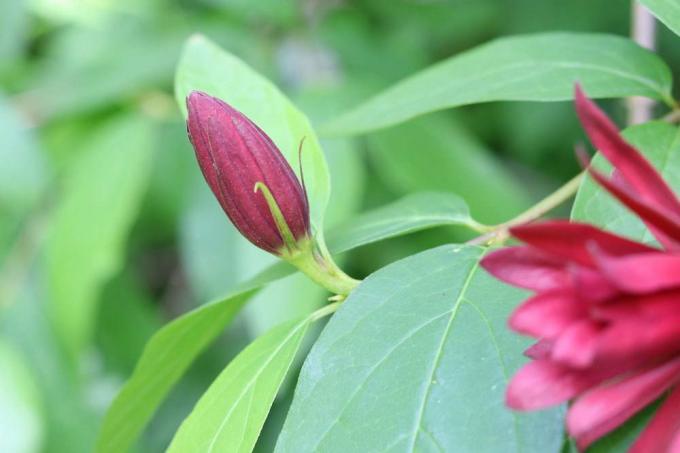
The substrate used should be loose and permeable. It should be able to store water and nutrients well. In addition, excess water should be able to drain off easily at all times. In order to meet these requirements, one can use commercially available Potted plants- or mix potting soil with coarse proportions such as expanded clay, perlite or lava gravel. The plant is placed in the middle of the pot and filled with soil up to a maximum of 2 - 3 cm below the edge of the pot. This edge is important to prevent irrigation water from running off over the edge of the pot. After planting, press the soil down and water it abundantly.
Tip: So that the lush roots of this spice bush can and not spread unhindered it should be repotted in a larger bucket and fresh substrate about every 2-3 years will. As a rule, the earth is then depleted accordingly.
to water
Calycanthus floridus is one of the moisture-loving plants, which makes a good soil storage capacity all the more important. It copes much better with short dry periods than with waterlogging.
- Soil should not dry out completely and be evenly moist at all times
- Increased water requirement immediately after planting and in the first few weeks afterwards
- accordingly, water regularly during this time
- later water at regular intervals, especially in summer
- Always adapt the watering behavior to the natural amount of rain
- Pay particular attention to sufficient moisture during the flowering period
- Basically, potted plants always need a little more water
- here the bale dries out much faster than in the garden
- Check the substrate daily for sufficient soil moisture during the warm season
As for the amount of watering, it is better to water regularly and thoroughly. If you water often but only in small amounts, it can happen that the lowest roots die off, because that Due to the small quantities, irrigation water does not penetrate to the bottom of the pot and ultimately the roots dry up. Increased leaf loss can be an indication of dryness in the root area, for example.
Fertilize
As far as the nutritional requirements are concerned, specimens planted in the garden in spring and summer can use a fresh layer of mulch made of compost or humus, no additional fertilization is required will. Over-fertilization is therefore ruled out. The situation is different with plants kept in pots.
As with the need for water, the need for nutrients is also slightly higher here, because the space in the root area is limited. So the risk of over-fertilization is correspondingly greater. Freshly planted specimens do not need any additional fertilizer in the year they are planted, standard flower or container plant soils are usually pre-fertilized. Only from the second year onwards can an immediately effective complete fertilizer be administered at regular intervals, or a suitable long-term fertilizer in March.
Cut
Thin out
At the end of winter, before the new shoots, minor pruning measures are often required on this spice bush in order to keep the plant in shape and healthy. If possible, you should avoid pruning this plant as it would impair the flower formation.
Experts advise you to only use sick, dead, stunted, inward-growing and crossing branches or branches. Cut out shoots at the base. Due to the oppositely arranged buds, this wood often develops so-called bifurcations, consisting of two equally strong shoots. From these two shoots one always removes the one that grows upwards or inwards.
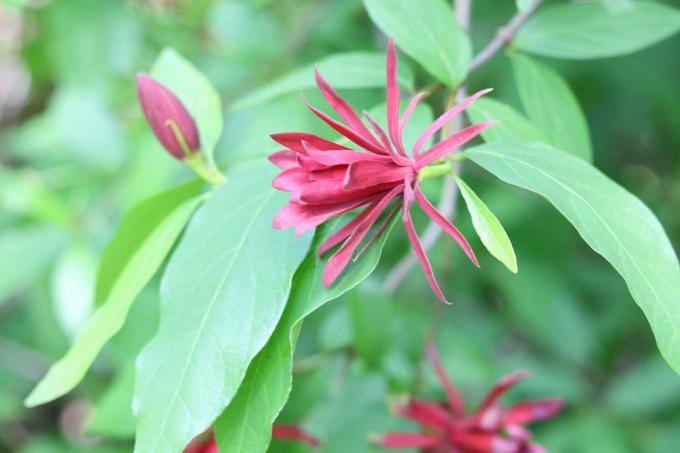
Rejuvenate
An exception are bushes that have been neglected for a long time and that have already aged, where radical rejuvenation pruning is usually unavoidable. The thickest and oldest shoots can be cut out close to the ground. As soon as the spice bush has formed enough young shoots again, leave the desired number and remove the others. If not enough new shoots have formed this year, you wait until the next one.
By the summer, extra-long shoots are then cut by around half. New shoots form again below the interfaces. These will be streamlined in the following year. With such a rejuvenation cut, flowering will not take place in the next few years. If such plants are not pruned more strongly, the flower formation will definitely suffer and gradually decrease.
Tip: If uncontrolled spreading is to be prevented, individual offshoots can easily be cut off with a spade, for example.
Overwinter
The real spice bush has good winter hardiness in our regions and can easily overwinter in the garden. In protected locations, it tolerates temperatures of down to minus 20 degrees without being damaged. However, young plants should still receive winter protection in the first few years, especially in particularly cold locations.
- Cover the root area up to the trunk with a thick layer of mulch
- Wrap above-ground parts of the plant with fleece or jute for protection
- As soon as the temperatures no longer drop below minus 10 degrees, the fleece can be removed
- older specimens usually come through the winter without any protection
- Do not let the soil dry out completely, even in winter
- There is no fertilization in the cold season
Container plants are generally a bit more sensitive when it comes to winter hardiness. However, this herb can also hibernate outdoors in a bucket. However, they should either be placed on feet or a styrofoam plate to protect the root area from freezing through. Since the spice bush loses its foliage in winter, it does not need to be protected from frost drought. If you want, you can also overwinter them in a cool but frost-free room in the house.
Tip: In the case of planted spice bushes and in the tub, the substrate should not dry out completely, even in winter, and should be kept slightly but evenly moist. Water only on frost-free days.
Multiply
The real spice bush reproduces naturally by forming offshoots. It can also be propagated manually via these cuttings, as well as by sowing or by cuttings. Gloves should be worn when handling fruits and seeds due to their toxicity. Prolonged skin contact should be avoided if possible and children and pets should be kept away.
sowing
The seeds for propagation can be bought in specialist shops or harvested from existing plants. To do this, wait until the seed pods that develop after flowering dry up or have turned brown. Then they can be harvested from the bush and the seeds removed. Don't forget to wear gloves, the seeds are very poisonous. The freshly harvested seeds should be sown as soon as possible.

- In principle, sowing is possible all year round
- but should preferably be done in autumn / winter
- Pre-treat or treat purchased seeds before sowing. undergo cold treatment
- to do this, first pour hot water over the seeds
- then let it swell for about 24 hours
- Put the pre-soaked seeds in a plastic bag with some damp sand
- the whole thing in the refrigerator for 4 - 6 weeks
- then it can be sown
- Mix commercially available potting soil or Kokohum with sand or perlite for cultivation
- Sow seeds about 1 cm deep, press the substrate lightly and moisten
- Keep evenly moist until germination, but not too wet
- Place the sowing vessel in a bright place with a constant temperature of 18 to 20 degrees
It can take up to 12 weeks for germination. For the first two years after germination, the young plants should overwinter indoors at temperatures between zero and five degrees. Only when they are older are they robust and resilient enough to be planted in the garden and be able to stay there permanently.
Cuttings
Propagation using cuttings is a bit less complicated. They can be used in summer as soon as the shoots mature or are completely lignified, cut from the mother plant. You should be approx. Be 15-20 cm long and have 4-5 buds. The lower end is cut diagonally and the upper end straight, so that it is not later put into the earth with the wrong end. At best, the interface is a bud or an eye opposite.
After the cut, the cuttings can be stuck into the ground in a partially shaded spot in the garden, and only deeply so that the topmost eye can look out of the ground. The buds in the ground gradually develop roots. The soil in the planting area should always be evenly moist. In a cool summer, the cuttings can be covered with plastic hoods to create a climate favorable for rooting.
Offshoot
Propagation by cuttings takes place directly on the mother plant. In summer you choose a young, lateral and strong shoot that remains on the plant and either in a pot with it Earth or bent down directly to the ground, covered with earth and weighted down with small wires or a stone if necessary will.
The tip of the shoot should look out of the earth. The soil is re-moistened and kept evenly moist until the roots form. The offshoots are usually rooted by next spring. They can be separated from the mother plant and planted in their final location.
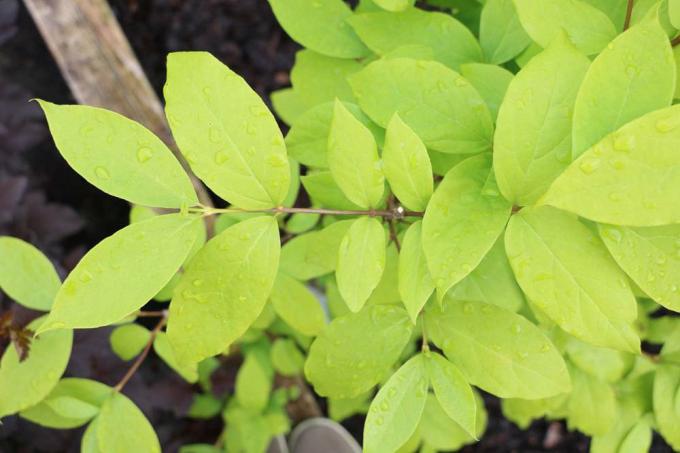
Diseases
Because of its scent, the real spice shrub Calycanthus floridus is avoided as far as possible by most harmful insects and fungal pathogens. However, too much moisture can cause root rot. To avoid this, you should always pay attention to the best possible site conditions and that Watering behavior can be adapted to the weather conditions and the needs of this plant. If this disease is noticed early, the affected plants should be transplanted into drier substrate immediately. In this way one can possibly save them from dying off.
